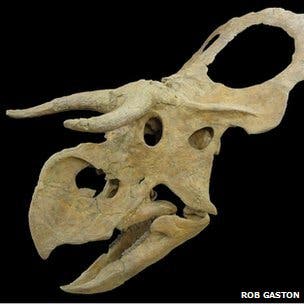A new, unusual species of dinosaur has been discovered in the deserts of Utah.

The 5m-long is a member of the triceratops family, and as fierce as they may look, this dinosaur was a herbivore. The huge ‘nose’ and exceptionally long horns are unlike any other dinosaurs previously described, which explains its name – Nasutoceratops titusi, which basically means big-nose, horn-face.
This dinosaur just completely blew us away”, explained Dr Mark Loewen, from the University of Utah and Natural History Museum of Utah. “We would never have predicted it would look like this – it is just so outside of the norm for this group of dinosaurs.”

The fossils were unearthed in 2006, but it took a long time for them to be prepared and for the study to finish. The rocks in which it was found are some 75 million years old, so we can trace its origins to the late Cretaceous. But its facial features draw all the attention.
“The horns are by far the absolute largest of any member of its group of dinosaurs – they curve sideways and forwards,” explained Dr Loewen. “In addition it has the biggest nose of its group too.”
The area in Utah where it was found once belonged in a continent called Laramidia – an island continent that existed during the Late Cretaceous period (99.6–65.5 Ma), when the Western Interior Seaway split the continent of North America in two. Laramidia stretches from modern-day Alaska to Mexico, and the area is typically very rich in dinosaur fossils.
Other plant-eating species, including two other kinds of horned dinosaurs and duck-billed hadrosaurs, were found close to Nasutoceratops titusi, suggesting that these creatures coexisted, eating tropical plants side by side for millions of years – which is kind of strange. These dinosaurs were really big, and they were fighting for the same food – how they got along with it is somewhat a mystery.
“All of these animals are upwards of three tonnes… You have an environment where you have all of these large herbivores competing for food. We aren’t really sure how you can support all of these animals, but you do find them all in the rock at the same time.”






